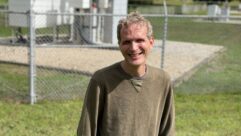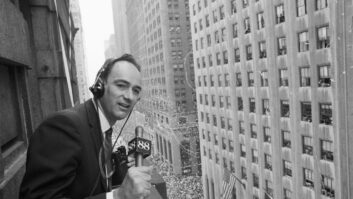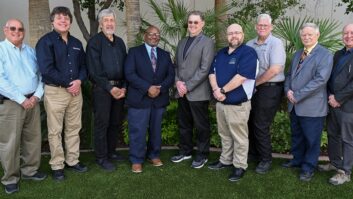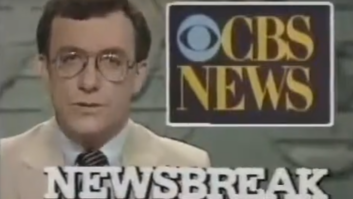Something new for news radio
Sep 1, 2007 12:00 AM
Moving a radio station that”s been in one place for three and a half decades is one challenge, moving the only all-news station in Philadelphia is quite another. The entire process had the potential of inducing culture shock across every department in the station.

Air Studio A, which is a mirror image of Air Studio B, has a corner view of the Philadelphia skyline.
For 35 years CBS Radio”s KYW Newsradio, Philadelphia, shared space with sister television station, KYW-TV, CBS 3. KYW Newsradio enjoyed the benefits of the TV infrastructure in a building purpose-built as a TV broadcast facility. Even with several rebuilds and tech- nology upgrades along the way, the analog backbone of the facility remained basically the same. The move was an opportunity to update the facility, upgrade the infrastructure to a digital, router-based system and have an individual identity in the marketplace.
Building selection was handled from the corporate real estate section of the company and this allowed us to concentrate on layout and technical planning. Fortunately, the cho- sen building was on the same city block and physically connected to the building we were exiting. Additionally, the STLs and other anten- nas for the station were actually located on the roof of the new building. This of course saved much time and many dollars in establishing microwave links to the transmitter site.
Design objectives
The goal of the design for the new facility was to be versatile, redundant, reliable and easy to use. We used Peter Bloomfield and Associates for the design process. We have worked with the firm before, which has an extensive broadcast design resume. The firm fully understands the function and flow of broadcast facilities. We not only needed a functional design but a look that was consistent with KYW”s position in the Philadelphia marketplace.

The lighting in the hallway can be set to change color automatically or fixed on a selected color.
The newsroom and studios were to be very open with clear site lines from the news desk to all critical areas of the operation. Studio windows and glass were strategi- cally placed and approved by the news director and staff. Two air studios, both identical in function, were also part of the design. Both air studios accommodate an anchor/co-anchor arrangement. The redundant studios allowed for preventative maintenance that was not easily handled at the old facility. Console layout and equipment placement involved the input from the staff. The end-users of the space were involved in the process along the way.
The technical objectives of the design were to be as flexible and repetitious as the physical layout. A digital infrastructure was the only choice. The need for rapid changes in the technical environment with the limited personnel resources of today is one of the major benefits of a digital platform.
Legacy equipment was limited to the digital audio stor- age system and the Burli newsroom system, in addition to select pieces of peripheral audio gear. Everything else was to be replaced due to age, obsoleteness, or the fact that it was shared with the television station.
Hardware selection
SAS was selected for the console and routing system. The system met all of the technical and operational requirements of the KYW newsroom. Additionally, SAS was employed at our other sister stations in the market. Uniformity in system selection also provided the benefit of familiarity and support for all of our stations in the market.
One of the problems in configuring a digital system after so many years of analog habits is convincing the staff that they will actually have more functionality and flexibility in a system that appears to have less control and a physically smaller foot-print. It wasn”t until the system was operational that everyone could see the benefits. Accessing audio sources and making changes to the system layout were now normal operating procedure or a simple programming task. No changes to wiring; no patch cords.
Next, we decided on furniture for the studios, newsroom and news desk. We used Studio Technolo- gies for the studio furniture. Located in Philadelphia, the company was willing to work with us on a very tight installation and integration schedule. We specified Corian tops on the air-studio furniture since they receive the most wear and tear. We were planning ahead for the wear of another 35 years. Traditional laminate with T-edge molding was used on all of the other studio work surfaces.
Systems furniture was used for the Writer”s stations in the newsroom. We were able to configure the systems for the needed visibility from the news desk and achieve the custom look we wanted at an off-the-rack price. The custom requirements for the news desk and its physical size made it an architectural feature of the newsroom and became part of the custom mill work scope.
Something new for news radio
Sep 1, 2007 12:00 AM
Power needs
A single 30kVA UPS is used to hold all critical equipment up during any change from utility power to emergency generator power. A 180kW diesel generator available from within the company was used to supply emergency power. This is the first time the station”s emergency system has been independent from utility-provided fuel. Utility power is supplied to the building on two independent feeders adding to the reliability of Utility power.
Integration of the entire system was managed through Radio Systems. The com- pany is local to the area and worked with our extraordi- narily short schedule for integration brought on by delays and complications with construction. Extend- ing the timeframe of the project was not an option because there was a hard exit date from the existing facility with financial penal- ties. Plus, it was set to be demolished.

One of three rows of racks in the technical operations center.
With the studio furniture being constructed in Phila- delphia, we were able to have it all shipped to Radio Systems to be pre-wired. This allowed integration tasks to occur at a time when the space had not yet been turned over to us. As soon as the studio furniture could be set in place, it was not only quickly installed but studio wiring was nearly complete. In some cases, studio equipment was already mounted in the furniture.
Studio-to-TOC cabling was performed as part of the construction contract. For the most part, the entire facil- ity is wired with CAT-5e multi pair cable. The TOC was released for integration before the rest of the space. Radio Systems worked with a cabling company to speed the installation of the backbone wiring to the TOC. With the use of Studio Hub as the wiring system, the TOC came together relatively quickly with few wir- ing errors. Wiring updates were easily accomplished because in most cases it was only a matter of moving a cable to another RJ-45 connector. Pre-wiring the studios off-site saved both time and money and allowed the facility to be test-ready in less than two weeks from furniture delivery.
Rack layout and documentation was done in advance so chunks of work were delegated and performed almost around the clock. Given the short and diminishing time line, integration occurred around the construction contractor as they finished trim and punch list items.
Move in day

Looking into Air Studio B from the newsroom. Air Studio A is to the right.
SAS remained on-site after initial programming to insure against operational problems and to cover programming changes for items that may have been missed during the initial configuration, or added as scope changed. The system was tested from microphone to STL and was air- ready. To make the transition seamless, the new facility fed the back-up STL and the handoff could be made via remote control.
When something goes wrong in life, it will often be at the worst possible time. On the night of the switch to the new facility, everyone from the engineering staff, the integrator and SAS representatives were on-site to resolve any problems. Then it happened: The new building experienced a power failure. At least response time was immediate. The incident was very revealing and tested all of our back-up systems. We also discov- ered that some things were on emergency panels that shouldn”t have been and vice versa. With that out of the way, there was a new confidence that everything would be right the next time there is a power failure.
KYW went on the air from the new facilitywith very few problems. Most of the issueswere operational and resolved when everyone became familiar with the studio layout.
Now that it”s finished
There were challenges throughout this project. As I mentioned before, delays related to construction did not give us the time we would have liked for integration and training. Most of the delays were from surprises due to issues that come with a 36-year-old building. These included, but were not limited to ADA compliance, life safety and general changes in the building codes that required updating during construction. Budgets had to be modified due to an unprecedented rise in the cost of construction materials.

The small conference room is at the end of the hallway.
Although pre-integrating the furniture off-site saved time and the cost of labor, this created another problem in the area of assembling the furniture when it arrived. Some of the wiring devices and equipment were in the way of key fastening points and this slowed the furniture installation.
The HVAC main and supplemental systems were designed around specifications supplied by the building management. Upon completion of construction, build- ing-delivered air did not meet specified parameters. This meant several office areas were not as cool as they should have been. Rebalancing of the system has resolved most of those issues.
After the dust had settled and the moving boxes had been emptied, everyone was proud to be a part of the new facility. There is an intangible benefit to the entire operation when employees feel good about the environ- ment they work in. The new studios for KYW met all of the design goals we set at the beginning of the project and the result is a facility that will be easy to use and manage into the future.
Steinnagel is the Mid-Atlantic director of engineering/mid-Atlantic for CBS Radio.
Facility photos courtesy of Bloomfield and Associates, except TOC, which is courtesy of KYW.
KYW Equipment List
- Air Tools 6100
- Belar LP-1a AM
- CBT Classic On-Air Light
- Circuitwerkes AC-1, AC-12
- Crown D-75
- Digidesign Mbox 2
- Digigram VX222 v2
- Electro-Voice 309A, RE-16, RE-20
- Enberg BA12CTL, BA12WL, FN3
- ESE LA12F, ES-185U/NTP, ESE HR TOH
- Eventide Eclipse
- Fostex 6301B, RM-1
- Harris Intraplex HD Plus
- Henry Engineering Matchbox
- HHB CDR-830 Plus
- JBL 4408
- JK Audio Quick-tap
- Microwave Filter FD6367
- Middle Atlantic Drift, Gang-10 Kit, Mag-1/2, MRK-4031, MRK-4036, MV-RR40, MW-VT, PD-1220J-IG, RSH4A3S, SPN-40-312, SPN-40-36
- O.C. White long and short booms, risers
- Omnimount 30.0 CA-PA, MT600
- Radio Systems DI-2000, integration services, Studio Hub+
- Rainwise MKIII
- Rane HC6
- SAS Rubicon SL
- Sony 7506
- Soundcraft EPM-6
- Studio Technology furniture
- Symetrix 528E
- Tascam MD-350
- TOA A906 Mark II
- Yamaha SPX-2000











